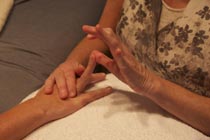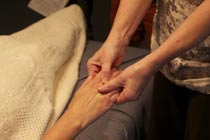Reflexology
The History of Reflexology
 The history of Reflexology originates from an ancient Egyptian wall painting during the 6th Dynasty (about 2300 B.C.) which was found in a physician's tomb at Saqqara, Egypt. The painting portrays "two men working on the feet and hands of two other men" (AboutReflexology.com).
The history of Reflexology originates from an ancient Egyptian wall painting during the 6th Dynasty (about 2300 B.C.) which was found in a physician's tomb at Saqqara, Egypt. The painting portrays "two men working on the feet and hands of two other men" (AboutReflexology.com).
Reflexology symbols are also believed to "be recorded on the feet of statues of Buddha in India and later China" (UMCSH & LSF). The Yellow Emperor's Classic of Internal Medicine, the Chinese classic medical book which was written about 1,000 B.C., spends a whole chapter on "Examining Foot Method"(UMCSH & LSF). This marks "the begining of discussions in print about the connection of life force and points and areas on the feet" (UMCSH & LSF).
It's believed that Marco Polo translated a Chinese massage book into Italian in the 1300s and introduced Reflexology massage to Europe (UMCSH & LSF). A book examining "an integral element of Reflexology" called zone therapy was first published in 1582 in Europe by Dr. Adamus and Dr. A'taitis (UMCSH & LSF).
 Refloxology was then introduced into the United States in 1913 by William H. Fitzgerald, M.D. (1872-1942) (Barrett, 2004). He found "ten vertical zones that extended the length of the body" (UMCSH & LSF). Dr. Shelby Riley expanded Dr. Fitzgerald's work by developing a map of horizontal zones of the body and a detailed map of reflex points on the feet and hands. Eunice D. Ingham (1899-1974) further developed reflexology in the 1930s and 1940s by focusing her research on the foot reflexology (Barrett, 2004). Her foot maps are still used today all around the world (UMCSH & LSF). Dr. Paul Nogier developed a reflex map of poins on the outer ear in 1957. Oleson and Flocco further researched his work and ear reflexology is now becoming a crucial part of Reflexology (UMCSH & LSF).
Refloxology was then introduced into the United States in 1913 by William H. Fitzgerald, M.D. (1872-1942) (Barrett, 2004). He found "ten vertical zones that extended the length of the body" (UMCSH & LSF). Dr. Shelby Riley expanded Dr. Fitzgerald's work by developing a map of horizontal zones of the body and a detailed map of reflex points on the feet and hands. Eunice D. Ingham (1899-1974) further developed reflexology in the 1930s and 1940s by focusing her research on the foot reflexology (Barrett, 2004). Her foot maps are still used today all around the world (UMCSH & LSF). Dr. Paul Nogier developed a reflex map of poins on the outer ear in 1957. Oleson and Flocco further researched his work and ear reflexology is now becoming a crucial part of Reflexology (UMCSH & LSF).
Karen Ball was trained and certified by the Reflexology Association of Canada as an instructor in 1985 and has been a licensed bodywork practitioner since 1983. She is also the creator of the 315-hour Therapeutic Hand & Foot Reflexology Professional Certification offered since 1996 (find more information about Karen). In this video, she talks about the history of Reflexology.
What Is Reflexology ?
Reflexology is a type of modality that deals with the reflex areas in the feet, hands (or ears) which are believed to be linked to glands, organs and parts of the body (International Institute of Reflexology; The Pacific Institute of Reflexology). By proper manipulation of those reflex areas, for example, using special "micromovement techniques such as thumb or finger walking and hook and backup", Reflexology can have therapeutic effects on different parts of the body (UMCSH & LSF; Barrett, 2004).
Where Are the Reflex Points or Areas?
Although there is no agreement on the exact places where each reflex point or area locates, Reflexology practitioners do have general agreement on major reflex points or areas of the body (UMCSH & LSF). The following are two charts that illustrate major reflex areas on the feet and hands.Source: Reflexology Research Project Presents
Source: Reflexology Research Project Presents
Health Benefits
 Although Reflexology is not used to diagnose or cure health disorders, a lot of people around the world use it to complement other treatments when dealing with conditions such as anxiety, asthma, cancer treatment, cardiovascular issues, diabetes, headaches, kidney function, PMS, and sinusitis (UMCSH & LSF; Rodriguez). Reflexology can also reduce stress, tension, chronic fatigue, improve circulation, digestion, provide pain relief of the neck, shoulders, back and jaw, and promote the natural function of various areas of the body (AboutReflexology.com). At the same time, awareness of one's body is increased (The Pacific Institute of Reflexology).
Although Reflexology is not used to diagnose or cure health disorders, a lot of people around the world use it to complement other treatments when dealing with conditions such as anxiety, asthma, cancer treatment, cardiovascular issues, diabetes, headaches, kidney function, PMS, and sinusitis (UMCSH & LSF; Rodriguez). Reflexology can also reduce stress, tension, chronic fatigue, improve circulation, digestion, provide pain relief of the neck, shoulders, back and jaw, and promote the natural function of various areas of the body (AboutReflexology.com). At the same time, awareness of one's body is increased (The Pacific Institute of Reflexology).
Reflexology "improves the assimilation of nutrients to enhance the provision of nourishment for healthy functioning", "improves the circulation of the blood and lymph with consequent improved nourishment and cleansing of the cells and elimination of accumulated toxins", "strengthens the functioning of the immune system" and finally helps the body "in it's inherent process of healing" "by revitalizing and rejuvenating the intricate functioning of the physicial body" (Shirley). Ball also contends that Reflexology provides a way to make the body's nervous system naturally shift "into a parasympathetic state (a condition that relaxes muscular function, promotes balance, and creates the internal environment in wihch healing can occur)".
